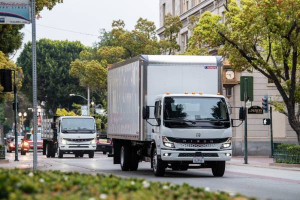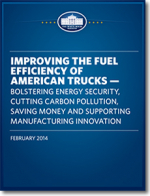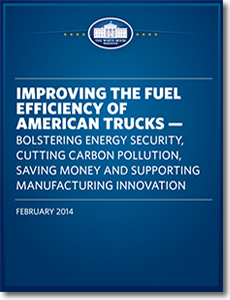Improving the Fuel Efficiency of American Trucks
Bolstering energy security, cutting carbon pollution, saving money and supporting manufacturing innovation.
Year of Action: Making Progress Through Executive Action
In his State of the Union address, the President outlined a comprehensive agenda to make America a magnet for middle class jobs and business investment.
The President highlighted the autoworker, who, implementing the Administration’s historic fuel economy standards, “fine-tuned some of the best, most fuel-efficient cars in the world, and did his part to help America wean itself off foreign oil.”
And the President pledged, “in the coming months” to “build on that success by setting new standards for our trucks, so we can keep driving down oil imports and what we pay at the pump.”
The President also called on Congress to do its part “by putting people to work building fueling stations that shift more cars and trucks from foreign oil to American natural gas.”
The President has laid out additional details for his plan to improve the fuel efficiency of American trucks – bolstering energy security, cutting carbon pollution, and spurring manufacturing innovation.
Directing the Environmental Protection Agency (EPA) and the Department of Transportation (DOT) to Set the Next Round of Fuel Efficiency Standards for Medium- and Heavy-Duty Vehicles.
The President is directing the EPA and the DOT’s National Highway Traffic Safety Administration (NHTSA) to develop and issue the next phase of medium- and heavy-duty vehicle fuel efficiency and greenhouse gas standards by March 2016. Under this timeline, the agencies are expected to issue a Notice of Proposed Rulemaking (NPRM) by March 2015. This second round of fuel efficiency standards will build on the first-ever standards for medium- and heavy-duty vehicles (model years 2014 through 2018), which were proposed and finalized by this Administration and will save vehicle owners and operators an estimated $50 billion in fuel costs and save a projected 530 million barrels of oil.
Partnering with Private-Sector Leaders to Deploy Advanced Vehicles
In addition, the President highlighted the success of the National Clean Fleets Partnership that he launched to speed the deployment of clean, energy-efficient vehicles and the infrastructure to support their use. This public- private partnership helps the nation’s largest fleet operators reduce diesel and gasoline use in their fleets by incorporating alternative fuels, electric vehicles and fuel-saving measures. To date, 23 major national companies, such as ARAMARK, Coca-Cola, Staples, UPS, AT&T, Enterprise Holdings, and Waste Management have joined the National Clean Fleets Partnership. Collectively, the National Clean Fleets Partners operate more than one million commercial vehicles nationwide. The President has directed his Department of Energy to provide each company that wants to partner with specialized resources, technical expertise and support in developing a comprehensive strategy to reduce fuel use and achieve greater efficiency and cost savings.
Expanding Fuel Choices for American Drivers
In addition to taking executive action to make America more energy independent and cut carbon pollution, the President is also renewing his call for Congress to end subsidies to oil and gas companies and create an Energy Security Trust Fund to fund research and development for advanced vehicle technologies. And he is proposing to support investment in advanced vehicles and infrastructure through a new tax credit and an extension of tax credits to support cellulosic biofuels.
Directing the Environmental Protection Agency (EPA) and the Department of Transportation (DOT) to Set the Next Round of Fuel Efficiency Standards for Medium- and Heavy-Duty Vehicles
The President is directing the EPA and the DOT’s National Highway Traffic Safety Administration (NHTSA) to develop and issue the next phase of medium- and heavy-duty vehicle fuel efficiency and greenhouse gas (GHG) standards by March 2016. Under this timeline, the agencies are expected to issue a Notice of Proposed Rulemaking (NPRM) by March 2015.
This second round of fuel efficiency standards will build on the first-ever standards for medium- and heavy-duty vehicles (model years 2014 through 2018), and will reach well into the next decade, just like the President’s successful national car standards.
Increasing the efficiency of medium-and heavy-duty vehicles (below referred to simply as heavy-duty vehicles) is a key component of the President’s Climate Action Plan to reduce carbon emissions. Heavy-duty vehicles represent a major opportunity to cut transportation oil use and carbon pollution. In 2010, heavy-duty vehicles represented just four percent of registered vehicles on the road in the United States, but they accounted for approximately 25 percent of on-road fuel use and greenhouse gas emissions in the transportation sector. They are currently the second-largest source of greenhouse gas emissions within the transportation sector (passenger cars and light trucks are the largest source).
The first round of standards for medium- and heavy-duty vehicles, finalized in September 2011, is projected to save 530 million barrels of oil and reduce GHG emissions by approximately 270 million metric tons, saving vehicle owners and operators an estimated $50 billion in fuel costs over the lifetimes of the vehicles covered. For example, an operator of a new 2018 semi truck could pay for the technology upgrades in under a year and realize a net savings of $73,000 through reduced fuel costs over the truck’s useful life.
What’s Related


Favorites





